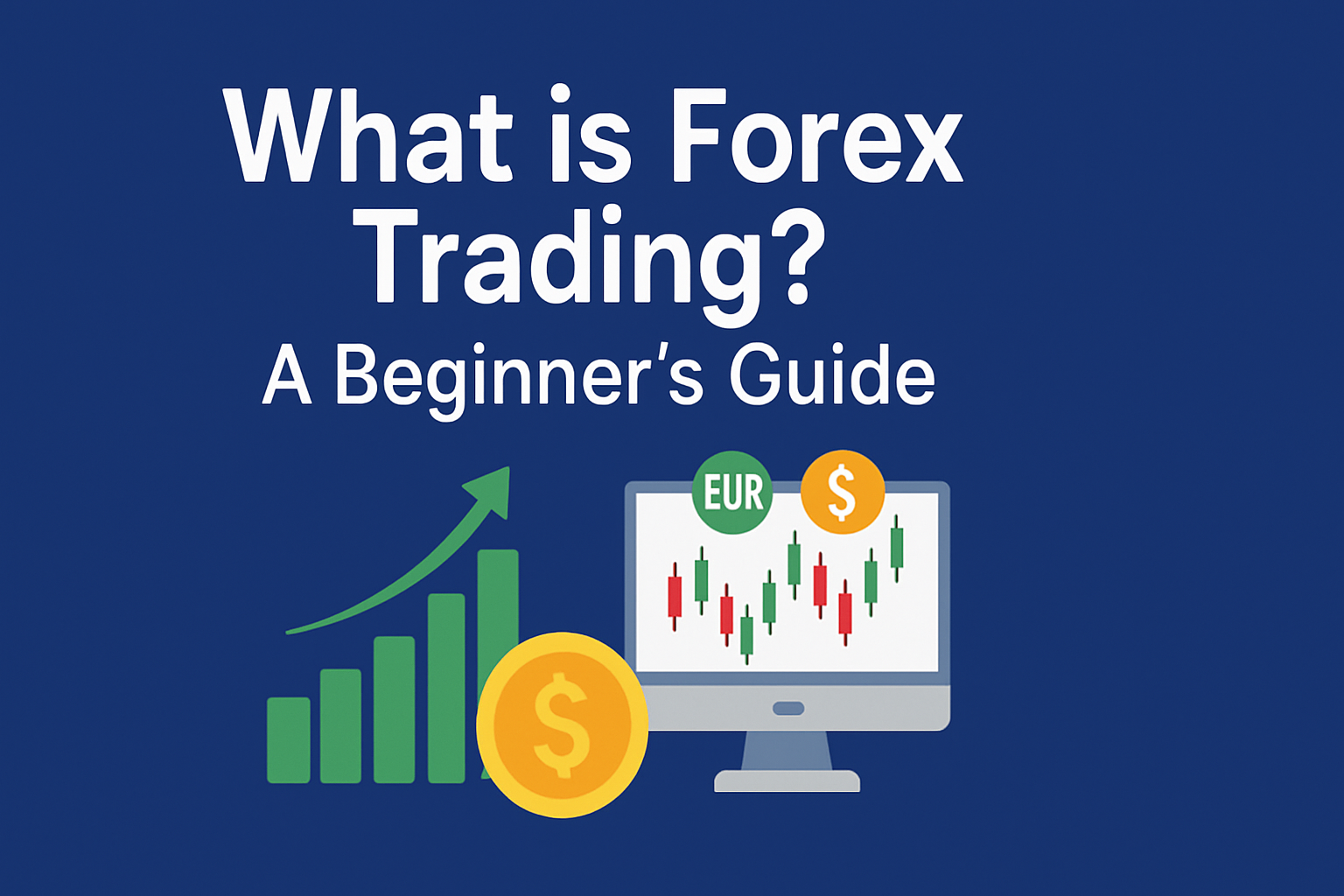What is Forex Trading? A Beginner’s Guide – Whether you’re planning a trip abroad, shopping online from an international store, or watching the news and hearing terms like “Dollar gained strength” — you’re brushing up against the world of Forex.
Forex trading (short for foreign exchange trading) might sound like Wall Street stuff, but with the right knowledge, even regular folks like you and me can understand and explore it. So, grab a cup of coffee and let’s decode the world’s largest financial market — the Forex market.

🧭 Chapter 1: What Exactly is Forex Trading?
Let’s break it down simply.
Forex trading is the act of buying one currency while simultaneously selling another. It happens in pairs, like EUR/USD (Euro/US Dollar) or USD/INR (US Dollar/Indian Rupee).
The goal? Profit from the change in value between the two currencies.
Let’s say:
- You believe the Euro will rise against the Dollar.
- You buy 1,000 Euros when 1 Euro = 1.05 USD (spending $1,050).
- A week later, 1 Euro = 1.10 USD.
- You sell your Euros and receive $1,100.
- You’ve just made a $50 profit.
Now imagine this on a larger scale with better timing and strategy. That’s Forex trading in action.
🌍 Chapter 2: Why Is Forex So Popular?
There are good reasons why Forex is one of the most traded markets in the world:
1. It’s Open 24/5
Unlike stock markets, the Forex market operates 24 hours a day, five days a week. You can trade before or after work, making it ideal for part-timers.
2. High Liquidity
Over $7 trillion is traded daily (yes, trillion with a T!). That means you can enter or exit trades without getting stuck.
3. You Can Start Small
With platforms allowing trades as low as $10 and leverage options, you don’t need millions to begin.
4. No Central Exchange
Forex operates globally through banks and financial institutions — it’s decentralized.
📚 Chapter 3: Key Forex Terminology (Beginner-Friendly Table)
Here’s a simple cheat sheet to understand what traders are talking about:
| Term | Meaning | Simple Example |
|---|---|---|
| Currency Pair | Two currencies traded | USD/JPY, EUR/INR |
| Bid Price | Price buyers are willing to pay | Broker buys at 1.1200 |
| Ask Price | Price sellers want | Broker sells at 1.1210 |
| Spread | Difference between bid & ask | 1.1210 – 1.1200 = 0.0010 |
| Pips | Smallest unit of price movement | 1 pip = 0.0001 for most pairs |
| Leverage | Borrowed money to trade more | 1:100 leverage = $1,000 becomes $100,000 |
| Lot | Size of trade | 1 standard lot = 100,000 units |
| Stop Loss | Auto close to limit losses | Trade closes at -$50 |
| Take Profit | Auto close to lock profits | Trade closes at +$100 |
💡 Chapter 4: How to Start Forex Trading – Step-by-Step
If you’re starting from scratch, here’s how to dip your toes into the Forex world:
Step 1: Learn the Basics
Take a few hours (or days) to understand terms, how the market works, and how currency pairs fluctuate. YouTube channels, free courses (like BabyPips.com), and podcasts are a great starting point.
Step 2: Choose a Reliable Broker
A good broker makes or breaks your experience. Look for:
- Regulation (FCA, SEBI, CySEC, etc.)
- Low spreads and fees
- Easy-to-use platforms (like MetaTrader 4/5)
- Demo accounts
Step 3: Use a Demo Account First
Before risking real money, trade on a demo account to get the feel of how everything works. It’s like a flight simulator before piloting a real plane.
Step 4: Start Small with Real Money
Once confident, deposit a small amount. Start with micro lots and keep your risk per trade low (no more than 1-2%).
Step 5: Keep a Trading Journal
Track your trades, emotions, and reasons behind decisions. This helps you learn from both wins and losses.
👤 Real-Life Story: How Raj From Delhi Made His First Forex Profit
Raj, a 27-year-old techie from Delhi, started trading Forex during COVID lockdowns. He began with a $200 demo account, practicing for 3 months. Once confident, he went live with $300.
His first real trade was buying EUR/USD based on a strong economic report from the EU. He made $25.
Not a fortune, but that small win gave him the confidence to keep learning and growing.
Today, he trades part-time and uses Forex as a second income stream.
🚫 Common Mistakes Beginners Should Avoid
- Overleveraging – Borrowing too much can wipe your account quickly.
- No Stop Loss – Always set a safety net.
- Revenge Trading – Lost a trade? Don’t jump back in emotionally.
- Lack of Patience – Forex rewards discipline, not quick gambling.
- Chasing News – Big events cause volatility. Avoid trading around major news unless you’re experienced.
📈 Is Forex Trading Profitable?
Short answer: Yes, but not for everyone.
Many beginners lose money because they treat it like gambling, not a skill.
Successful traders treat Forex like a business:
- They manage risk.
- They have a plan.
- They continuously learn.
It’s not a get-rich-quick scheme. But with time, discipline, and smart strategies, it can be a powerful income source or even a full-time career.
💼 Forex vs Stock Trading: What’s Better for Beginners?
| Feature | Forex | Stocks |
|---|---|---|
| Market Hours | 24/5 | Limited hours |
| Leverage | High (up to 1:500) | Lower |
| Volatility | High | Depends on company/news |
| Focus | Currencies | Companies/sectors |
| Ease of Entry | Easier | Requires research on individual firms |
Verdict: Forex is more flexible for beginners, but stock trading is easier to grasp conceptually.
📊 Tools Every Forex Trader Should Use
- Economic Calendar – Stay ahead of news (like FOMC meetings, GDP releases).
- Trading Platform (MT4/MT5) – To place trades and analyze charts.
- TradingView – Amazing for charting and indicators.
- Forex Factory – Great for news, forums, and strategy sharing.
- Risk Calculator – Helps you decide how much to risk per trade.
🧘 Final Thoughts: Should You Try Forex Trading?
If you enjoy:
- Analyzing charts
- Global economic trends
- Making money through calculated risks
Then Forex might just be your thing.
Start slow, stay curious, and don’t risk what you can’t afford to lose. It’s a journey — and if you treat it with respect, Forex can be a rewarding skill for life.
❓ FAQ: Beginner Forex Trading Questions Answered
1. Is Forex trading legal in the U.S. and India?
Yes, but with regulations. In India, you can only trade currency pairs approved by SEBI (e.g., USD/INR). In the U.S., it’s legal but requires using regulated brokers.
2. How much money do I need to start Forex trading?
You can start with as little as $10, but $100–$500 is a practical starting range with proper risk management.
3. Can I make a full-time income trading Forex?
It’s possible but rare for beginners. Most traders build up slowly over years. Start part-time and focus on learning first.
4. What’s the best time to trade Forex?
London and New York sessions (overlap time) — usually 1:30 PM to 5:30 PM IST — offer the most volatility and opportunity.
5. Is Forex trading risky?
Yes, like all financial markets. But with education, discipline, and proper tools, risks can be managed effectively.
If you found this guide helpful, share it with a friend who’s curious about trading or wants to explore a side hustle from home.
touchpur.com brings you fresh, real-world guides that cut through the jargon — so stay tuned for more!




